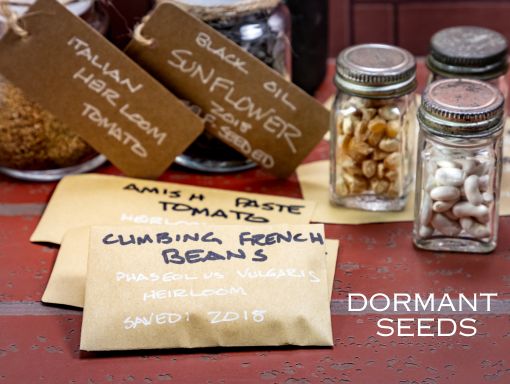I slumped in my cluttered office staring at a blank document on my laptop. I wanted to plan my next project, but my thoughts felt as cloudy, gray, and oppressive as the sky out my office window.
My creative well was dry.
“What is wrong with me?” I prayed, asking the Lord.
During this prayer time, a word floated into my brain: dormancy.
I mulled this word over. As a gardener, I know that some seeds go through a period of dormancy, so I decided to research this topic to figure out any parallels that could help me.
What Is Dormancy?
Definition
dormancy – A state of slowed or suspended growth.
I thought about the packets of seeds in my refrigerator waiting for me to plant them. Have you ever wondered why seeds don’t sprout in the packet? It’s because they are dormant.
Seed dormancy ensures the seed does not germinate when there is little chance the seedling will survive.

What Brings Seeds Out of Dormancy?
Gardeners read seed packages before planting to know how to plant their seeds. Important information to know:
- Many “common seeds” simply need the correct conditions to come out of dormancy. A gardener can encourage germination by planting the seed in soil and giving it the preferred light, moisture, and temperature requirements.
- Other seeds have a more complicated dormancy that prevents them from sprouting unless more complex conditions are met. Some seeds have a very hard seed coat that keeps them from germinating unless they have the shell disrupted by scratching it or soaking it in water to soften the shell. This process of applying external pressure is called scarification. Sweet peas are an example of this.
- Some seeds have a chemical inhibitor that slows germination until weather conditions are favorable, like the seeds of dogwood and crabapple. These seeds need a combination of moisture and cold or moisture and heat for several weeks before planting. This can happen naturally outside throughout the winter as the seed sits in the ground, or growers can force it through indoor stratification. It’s God’s way of protecting the seed. If it were to germinate in the fall after the plant expels the seed and it falls to the ground, the seedling would never survive the winter.
- A very few plants such as sequoia and lodgepole pine have seeds covered in such a thick resin that they need fire to sprout. The fire opens the cones, melts the resin, and releases the seeds.
 How Does This Apply To Me?
How Does This Apply To Me?
As I thought about seeds and their conditions, I thought about myself. What type of dormancy am I in?
Type 1. In the first example, the seeds are just hanging out in the seed packet. All the potential for life is there, but they are waiting. What they need is a good, nurturing environment. Perhaps I needed some nurturing myself to nurture ideas in my mind.
Type 2. Maybe my dormancy was caused because I have a “hard seed coat.” Have I put a shell of protection around myself because I’ve been hurt or I’m rebelling? God may be in the process of wearing down a tough exterior so that I can be used.
Type 3. Am I dormant because it’s simply not the right time yet? God has put an “inhibitor” on any ideas or their implementation. I need to wait for the right season for the next project as God puts all the details in place. This type of dormancy is protecting me, otherwise my idea will die an early death because it’s not the right season yet.
Type 4. I may be in dormancy because I am in a fiery trial in my life right now, and I am doing all I can to just survive. Perhaps there has been a death in the family, I am battling a diagnosis of illness, or I’m in a severely challenged marriage.
What About You
Perhaps like me, you find yourself in a period of creative dormancy. Or, if you’re not now, you will most likely at some point in your life. What can you do?
- Determine the type of dormancy you’re in. That will give you clues on how to come out.
- Pray for discernment as to what God is telling you to do right now.
- Journal what you hear. This is like reading the seed packet to see how to come out of dormancy.
Click on each button below to see how to break out of dormancy.
Type 1 Dormancy
If you feel you’re in Type 1, I would suggest immersing yourself in a good, nurturing environment. Rest. Get plenty of sleep. Eat nutritious food. Exercise. Read. Learn. Do things that stir up your creativity. If you are in the right conditions, your idea and your project will germinate and grow.
Type 2 Dormancy
If you suspect Dormancy Type 2, determine what is causing your hard seed coat. Are you hurt, angry, in protection mode? Deal with your feelings with God. Pray and ask the Holy Spirit to reveal what you need to change.
Type 3 Dormancy
If you’re in Dormancy Type 3, you will need to exercise your patience. It is not time yet. Again pray and ask God what it is you need to do if anything. If He gives you something, then do it. You do what only you can do, and then God does what only He can do. Most likely there is waiting involved on your part, which is never fun. You may need to move on to another idea as God works out His part.
Type 4 Dormancy
Finally, If you’re in Dormancy Type 4, you’re in fiery survival mode. Seek out help. Find a good counselor, prayer partner, and/or pastoral care. Drop everything that isn’t necessary or that drains you while you’re in this mode. You need to work through grief, anger, or despair. Concentrate on healing. Add activities back in as you recover. You may be in this type of dormancy for a while.
I will say dormancy #4 is the hardest and longest type to go through. If you are in survival mode, let me encourage you. I have been there too. God will use it at some point in your life to bless others.
I was in this type of dormancy after the death of one of my children. For a while, I shut down. I had a hard time functioning as God brought me and my family through that dark season. But he did. The timing of healing will be different for each of us, but it will happen if you let Him walk you through it. You must deal with it. You can’t bury it. Otherwise, you won’t heal, and you could be stuck in dormancy for years.
Summary
In my case, God revealed I am in Dormancy Type 1. I feel depleted from a busy season of life. I am resting, reading, praying, listening, journaling, and planning.
Remember, dormancy is not necessarily a bad thing. It’s a way to prepare for what God has for us next.

A Creative Hack for You
Lastly, I wanted to mention a short practice I started that may help you work through Dormancy. I call it Thrive in 30. I commit to working on a current passion project 30 minutes a day at least three days a week. So, no matter how busy I am with work or other obligations, it ensures I am continually engaged and progressing on my project. I eliminate the gaps of time when I haven’t worked on it and therefore lose my train of thought. It has helped immensely. Give it a try if you’d like!
How About You?
If this mini-tutorial on dormancy resonates with you, let me know if you’ve experienced dormancy and how you broke out of it. Or, if you have questions, drop them in the comments. Thanks!


 How Does This Apply To Me?
How Does This Apply To Me?


0 Comments